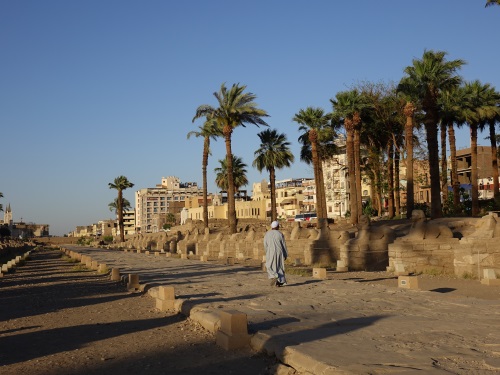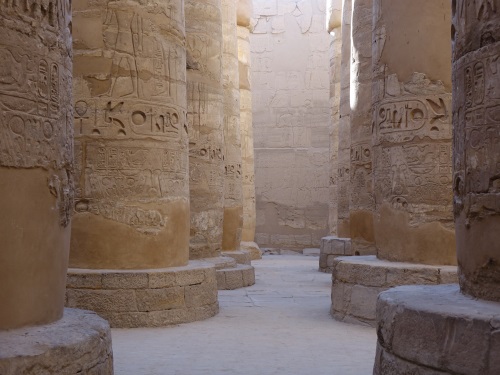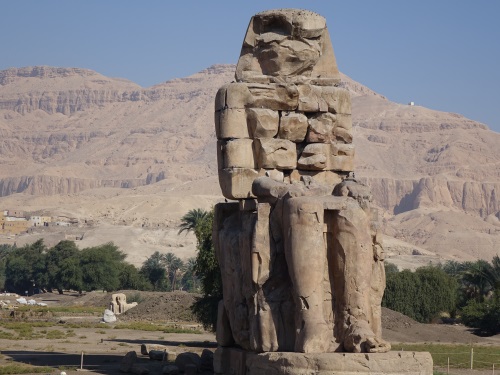Thebes, what we now call Luxor, is one of the most ancient “tourist” destinations in the world. Already the ancient Greeks came here to marvel at the temples that were built by the Egyptian pharaohs. Later Christian and Muslim generations had much less respect for their forefathers, so it wasn’t until the 19th century that these sites were rediscovered by Europeans. The 21st century has brought Asian tourism to the spectrum: the Chinese are the only nation that dare to come here today en masse. It became especially popular since a visit of president Xi Jingping to president Sisi in 2016, which partly took place in the inner courtyard of Luxor Temple.

Row of sphinxes from Luxor to Karnak
The site was already inscribed as a WHS in 1979, with epithets such as “splendid”, “monumental” and “unique and unequaled”. It is also part of our Top 200. Not much of substance has been written about it yet among our reviewers though (sorry guys). Important to know is that it comprises 3 locations: the temple of Karnak and the temple of Luxor on the East bank of the Nile, and the Necropolis on the West Bank. Especially the latter is a collection of many temples and tombs, scattered around in a rural area and at the foot of a barren mountain ridge.
On my first day, after having visited the excellent Luxor museum as an appetizer, I started with Karnak Temple. Heavy security measures are in place at this and Luxor Temple: cars are searched, trunks have to be opened. People have to pass security booths everywhere (similar to Paris, where I was a few weeks ago), and armed guards hover at strategic road blocks. There’s actually not much glory to be gained for a bomber at the moment – the parking lot was nearly empty. Karnak stands out for its size, the size of everything actually. Much has been taken away (such as the obelisk that now is at the Place de la Concorde in Paris) or has fallen down. Its prettiest feature is the hypostyle hall, a forest of 134 massive columns (much thicker than the average Roman or Greek ones).

Karnak, hypostyle hall
Luxor Temple lies at the heart of modern Luxor, there’s even a McDonalds right next to it. A long row of sphinxes once connected Luxor Temple with the Temple of Karnak, 3 km’s away. Egyptian authorities are now rebuilding this monumental path. I think it’s important to be aware that Luxor is still changing every day – the path is nearly finished, statues are put upright, colourful ceilings have been restored. Luxor Temple has more sculptures and carvings than Karnak, and I found it more atmospheric.
During my second day in Luxor I went to the necropolis on the West Bank of the Nile. I had a driver and a guide with me, and we first had to cross the bridge which lies 20 minutes or so south of Luxor. Life on the “other” side of the Nile seemed more rural, especially sugarcane is harvested. We first stopped at the Colossi of Memnon – two enormous statues that once guarded yet another huge temple complex. German archaeologists are still excavating here, and the outline of the complex and other statues can already be seen.
Afterwards we went to the Temple of Habu – the favourite of my guide, and I can easily understand why as it is the most intact of all around Luxor. The Ramses that had this built was especially proud of his slaughter of enemies, as shown by carvings of bunches of hacked-off hands (with a scribe next to it counting the numbers). The ceilings here are well-preserved too, including their colours. The only issue is that birds have taken over many of the niches that are present in the cut sandstone.

One of the Colossi of Memnon
Finally I did go and see some tombs. At the one of Ramose, a Noble, I was the only visitor. The Tombs of the Kings however are the masterpieces. And that’s where they all take the few tourists that are left in Egypts nowadays! There surely where over 100 buses and cars at the car park, mostly used by daytrippers from the Hurghada resorts. Certainly they weren’t staying in Luxor. An entrance ticket here gives you access to 3 of the tombs out of the 12 or so that are open. Some “special” tombs (like the one of Tutankhamon) can only be entered for an extra fee. On recommendation of my guide I went into tombs number 6, 8 and 2. One with the longest corridor deep into the mountain, the other two with fantastic bright paintings. The lighting is very good, so one can really enjoy it all. Photography is forbidden in the Valley so you have to go and see it for yourself.
@Solivagant: the photography restrictions already start right behind the visitor center, there's a booth where all cameras have to be surrendered (I left mine in the car). So you evén aren't allowed to take pictures of the part of the valley with the many entrances to the tombs. Some people with cell phones did so however, it seems strange that the Egyptians are unaware of the photographic capabilities of smartphones.
When you say "Photography is forbidden in the Valley" I presume you mean "forbidden in the tombs in the Valley"? We have visited the Luxor etc 3 times over the years - 1978, 1992 and 2006 and it has been a sorry story of additional restrictions and fears of terror etc replicated in so many places around the World. On the first occasion we hired bicycles in Luxor, took them across on a small ferry (no bridge then!) and just rode around all day to our heart's content, visiting whichever tombs we wanted on a single ticket. The Tombs of the Nobles were unlit and many of them had a man (or even 2) with a shiny sheet of metal which he/they used to reflect the sunlight down into the tomb from the top/half way down. Happy days. I have a fine set of photos of all the tombs taken with flash - no restrictions then. I understand that there is considerable doubt as to whether flash does actually damage colours and that the main reasons for restrictions are copyright and crowd management!